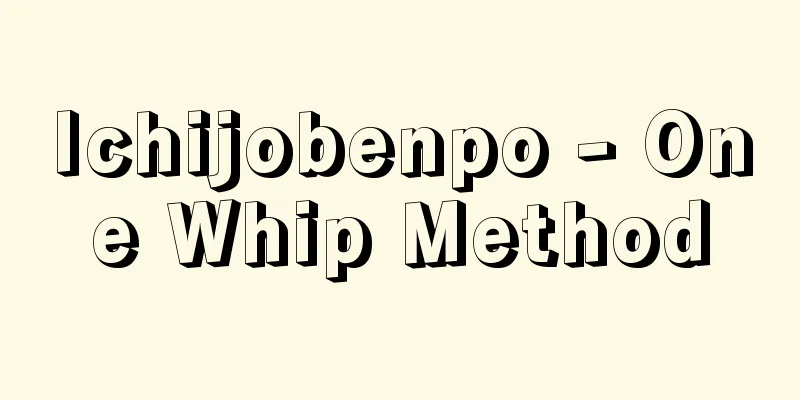Ichijobenpo - One Whip Method

|
A tax and forced labor system was implemented in China from the late Ming to the early Qing. Bai was also written as bien or bian, and was abbreviated to yitiao fa and tiaoben. The name was derived from the fact that the complex and diverse contents of taxes and labor were collected in one article. Ming taxes were collected in summer and autumn under the two tax laws that had been in place since the mid-Tang, and the principle was that they were paid in kind (honshiki) such as rice, wheat, raw silk, and silk. Forced labor consisted of rijia main labor and miscellaneous labor, and was centered on the conscription of actual labor. Taxes and forced labor were collected through the rijia system, which was a village organization, and allocations were made according to the weight of the tax and labor burdens based on the household rules (koso) (three levels and nine rules) that comprehensively evaluated the number of people in each household (jintei) and the amount of assets. In the early Ming Dynasty, taxes and duties were simple and the burden was relatively light, but the absolute amount of taxes and duties increased due to the construction of the capital palace, an increase in the number of civil and military officials, and increased military expenses for foreign expeditions. In particular, when Emperor Yongle (reigned 1402-1424) moved the capital to Beijing, it increased the burden of shipping labor and increased additional taxes (wages), and by the 15th century, both the taxes and duties had become complex and excessive in both number and content. In the mid-Ming Dynasty, as industry developed and silver began to circulate, the practice of paying taxes and duties in silver became widespread. This led to a system in which the contents of taxes and duties were expressed in silver, added up to arrive at a total amount, and this total amount was allocated to the land and people within a prefecture as confirmed by land surveys (joryo) and censors (henshin). A reform plan was proposed by the Great Scholar Gui Chuan in August 1530 and became a House of Representatives proposal in October of the same year. According to a report by the Censor Fu Hanchen in March of the following year, this was called the Ichijo Henpo (One Article Henpo), and the combined silver amount for the summer and autumn taxes and other taxes was set at a certain amount per hou (unit of area), and similarly, the amount of silver for forced labor was set at a certain amount per cho and a certain amount per hou. However, the Single Whip Law did not progress smoothly from this point on. There was strong opposition to its implementation, particularly in northern China, and it was not until Zhang Juzheng's (1580-82) enforcement that it became widespread. [Mamoru Kawakatsu] Source: Shogakukan Encyclopedia Nipponica About Encyclopedia Nipponica Information | Legend |
|
中国、明(みん)後期から清(しん)初に行われた税、徭役(ようえき)制度。鞭は編、辺とも記され、一条法、条鞭と略された。税、役各項の複雑多岐にわたる諸内容を1条にまとめて徴収したので、この名称が生じた。明の税は、唐中期以来の両税法により夏税、秋糧を徴収したが、それらは米、麦、生糸、絹などの現物(本色(ほんしき))納入を原則とした。また、徭役は里甲正役と雑役とからなり、実際の労働力の徴用が中心であった。税、徭役は郷村組織である里甲制を通じて収取されたが、税、役各項の負担の軽重に応じて、各戸内人数(人丁(じんてい))、資産の多寡を総合評価した戸則(こそく)(三等九則)によって割当てが行われた。明初は内容も簡単で負担も比較的軽かったが、都城宮殿の造営、文武官員の増加、外征軍費の増額などで税、役の絶対量が増え、とくに永楽帝(在位1402~24)の北京(ペキン)遷都が漕運(そううん)労役を重くし、付加税(加耗(かこう))を増大させたりして、15世紀には税、役ともに項目数も内容も複雑で過重なものとなった。 明中期には産業が発達して銀が流通し、税、役の銀による代納が普及すると、税、役の諸項内容を銀額で表示し、それぞれを合算して総額を出し、その総額を、検地(丈量(じょうりょう))と検丁(編審(へんしん))によって確認された一州県内の田土と人丁に割り当てる方法が始まった。1530年8月に大学士桂蕚(けいがく)が上申し、同年10月に戸部議案となった改革案は、翌年3月の御史(ぎょし)傅漢臣(ふかんしん)の上言によれば、一条編法とよばれていたが、夏秋両税などの合算銀額が畝(ほ)(面積の単位)ごとに若干両、同じく徭役銀も丁ごとに若干両、畝ごとに若干両とされていた。しかし一条鞭法は、これより順調に進展したのでなく、とくに華北には施行の反対論が強く、その普及は1580~82年の張居正(ちょうきょせい)の行った丈量以後のことであった。 [川勝 守] 出典 小学館 日本大百科全書(ニッポニカ)日本大百科全書(ニッポニカ)について 情報 | 凡例 |
<<: Ichijo return bridge - Ichijo return bridge
Recommend
Petau, D.
…However, the Christian era, which is now common ...
Mount Fuji - Fujiwara
A mountain in the northern part of the Suzuka Mou...
SID - SID
...In areas where there is no medical examiner sy...
Wrapping - Tsutsumi
[given name] 1. To wrap something in paper or clot...
Large box butterfly - Large box butterfly
…The Cossidae is a small family, with seven speci...
Lapithes (English spelling)
…in Greek legend, a tribe of people living in the...
Gyakushuuihai - Reverse memorial tablet
…After the 33rd anniversary of the death, the mem...
Asakusa paper
During the Edo period, this miscellaneous paper w...
Brøndal, V.
…He proposed his own theory of language, which he...
Kiichi Kaneko
1876-1909 A socialist in the Meiji period. Born o...
Tanzanite
...Thulite containing Mn is pink in color and is ...
Sawagurumi - Sawagurumi
A deciduous tree of the Juglandaceae (APG classif...
Battistello
…In the 17th century, Naples was ruled by a Spani...
Kurikara
The original word is unclear, but it is generally ...
District Court - Kusaibansho
A court established by the 1872 Judicial Duties Re...









